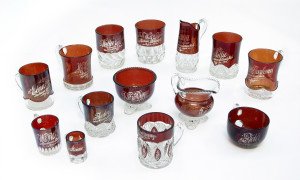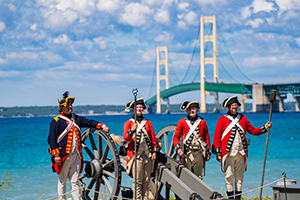Frank Kriesche came to America from Bohemia in the late 1800s where he had learned his trade as a glass engraver. He moved to Mackinac Island in the early 1890s and during the summers applied his talents at the glassware shop that he owned on Main Street. Kriesche would import some of the glass from Germany for his more expensive glassware but the pieces that he is most famous for are his ruby souvenir glasses.
 Ruby stained glasses were a popular souvenir during the turn of the century, between 1890 and 1910. Kriesche bought the cheaper pressed glass from American glass companies and engraved them to order with customer’s names and date of visit on the glass. The pressed glass was made by pressing the molten glass into molds. In the 1800s American glass companies used this process to mass produce glass and sold it in a wide variety of designs to glassware merchants and individual decorating firms which Frank Kriesche may have obtained his ruby glass from.
Ruby stained glasses were a popular souvenir during the turn of the century, between 1890 and 1910. Kriesche bought the cheaper pressed glass from American glass companies and engraved them to order with customer’s names and date of visit on the glass. The pressed glass was made by pressing the molten glass into molds. In the 1800s American glass companies used this process to mass produce glass and sold it in a wide variety of designs to glassware merchants and individual decorating firms which Frank Kriesche may have obtained his ruby glass from.
The first step for companies in applying the ruby coloring involved painting a chemical mixture including copper sulfate (which in most cases was used as a substitute for gold) on the glass in the places that they wanted the ruby color to be. They would then put the painted pressed glass in a kiln of about 1,000 degrees during which the high amount of heat would cause the chemicals to turn ruby red. When heated these chemicals would permanently adhere to the surface of the glass and could be scratched off. In order to engrave the ruby souvenir glass Frank Kriesche used a treadle lathe. This lathe comprised of a foot petal, in 19th century versions, that spins a copper wheel with an abrasive paste on it. This paste as well as the edge of the small maneuverable copper wheel work to grind off the ruby coloring on the glass. Kriesche used his glass engraving talents with the lathe to produce beautiful pieces of ruby souvenir glass.
Frank Kriesche’s ruby souvenir glasses not only captured the memories of the visitors who came to the island but also helped contribute to the culture of Mackinac Island and surrounding Mackinac region. Today, you can see his beautiful pieces on display in the Mackinac Art Museum on the island.









